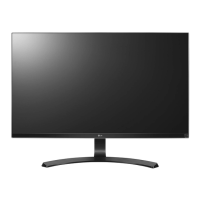
Do you have a question about the LG 27UD68 and is the answer not in the manual?
| Style | Flat |
|---|---|
| Color | Front Deco : Black texture |
| Screen Type | - |
| Stand Type | Simple |
| Wall Mount | 100 mm x 100 mm |
| Tilt | -2° ~ 15° |
| Sound | - |
| Features | HDTV-Monitor Combo |
| OS Compatibility | Windows |
| Interface Connectors | Composite In (AV) |
| Operation Conditions | - |
| Webcam | no |
| Screen Size | 27 |
| Panel Type | IPS |
| Aspect Ratio | 16:9 |
| Resolution | 3840 x 2160 |
| Refresh Rate | 60 Hz |
| Viewing Angle | 178°/ 178° |
| Response Time | 5 ms |
| Brightness | 200 cd/m² (min) |
| Contrast Ratio | 1200:1 |
| Pixel Pitch | 0.1554mm x 0.1554mm |
| Native Resolution | 3840 x 2160 |
| Horizontal Viewing Angle | 178 degrees |
| Vertical Viewing Angle | 178 degrees |
| Synchronization | freesync (amd adaptive sync) |
| HDR | no |
| Type | 40W Adapter |
| Power Supply | 50 / 60 Hz |
| Power Consumption | 45 W (Max) |
| Depth with Stand | 186.2 mm |
| Height with Stand | 455.7 mm |
| Width with Stand | 615 mm |
| Net Weight with Stand | 4.9 kg |
| Depth without Stand | 49.3 mm |
| Height without Stand | 365.1 mm |
| Width without Stand | 615 mm |
| Net Weight without Stand | 4.6 kg |
| Built-In Speakers | no |
| HDMI Ports | 2 |
Explains HDMI and DisplayPort logo usage and trademarks.
Content for European market regarding ErP Directive and automatic standby.
Lists all included components and accessories in the box.
Safety and usage notes for product components and accessories.
Details the monitor's components and the function of the joystick button.
Explains how to use the joystick for basic monitor functions like power and volume.
Shows and labels all input ports on the monitor.
Provides instructions for safely moving and lifting the monitor.
Lists crucial safety precautions when handling the monitor.
Step-by-step guide to attach the stand base to the monitor.
Warns against excessive force and potential damage during stand assembly.
Instructions for safely removing the stand base from the monitor.
Highlights safety measures and potential risks during stand removal.
Demonstrates how to organize cables using the provided cable holder.
Guide to positioning the monitor on a table with proper ventilation.
Steps for connecting the power adapter and plugging into the wall outlet.
Instructions on how to adjust the screen for optimal viewing angle.
Warnings to prevent finger injury and screen damage during angle adjustment.
Explains how to connect and use the Kensington security system cable.
Steps for attaching a compatible wall mount plate to the monitor.
Provides essential notes and cautions for installing the wall mount plate.
Guide for mounting the monitor on a wall with proper spacing for ventilation.
Important cautions regarding screw length, force, and VESA standards for wall mounting.
How to connect the monitor to a computer for display.
Steps for connecting the monitor to a PC or AV device via HDMI.
Instructions for connecting the monitor to a PC using a DisplayPort cable.
Important notes regarding PC connections, including Plug and Play and cable quality.
How to connect AV devices to the monitor using HDMI for audio and video.
Guide on how to connect headphones to the monitor's headphone port.
Tips on using straight earphones and potential audio limitations.
Instructions on how to access and navigate the monitor's On-Screen Display menu.
Lists and briefly describes the main functions available in the monitor's menu.
Details how to adjust basic settings like brightness, contrast, volume, input, and ratio.
Important notes regarding volume mute function and display options for ratio.
Guide to setting up and configuring the Picture-by-Picture display mode.
Notes on PBP mode functionality, disabling options, and optimal resolution.
How to select and customize picture modes for different uses like documents, photos, and games.
Notes on potential screen flickering or resolution issues when changing picture modes.
Details on adjusting sharpness, black level, ULTRA HD Deep Color, and DFC.
Notes about ULTRA HD Deep Color feature compatibility and potential issues.
Settings for game mode, response time, FreeSync, and Black Stabilizer.
Options for adjusting gamma, color temperature, and individual colors (RGB, Six Color).
Notes regarding FreeSync requirements and color adjustment parameters.
How to configure language, energy saving, power LED, standby, DisplayPort 1.2, and buzzer.
Notes on DisplayPort 1.2 compatibility and OSD lock features.
Instructions on how to reset all monitor settings to their default values.
Common issues and solutions for when the monitor shows no image.
How to resolve problems when the OSD menu is locked.
Explains image sticking and how to prevent it.
Solutions for screen flickering, shaking, or shadow trails.
Defines vertical and horizontal frequency for display.
Advice on checking graphics card resolution and frequency settings.
Solutions for discolored, unstable, or monochrome display issues.
Steps to resolve 'Unrecognized monitor' messages and driver installation.
How to fix problems with no sound from headphones or speakers.
Details about the LCD panel type, pixel pitch, and resolution.
Specifications for video signals, frequencies, and input ports.
Information on power consumption, adapter type, and output.
Details on operating conditions, stand adjustment, dimensions, and weight.
Lists supported resolutions and frequencies for HDMI factory mode.
Lists supported resolutions and frequencies for DisplayPort factory mode.
Table showing HDMI timing for various video modes.
Explains the LED color for different power modes (On, Sleep, Off).
Guide on maintaining good posture for comfortable and fatigue-free monitor use.
Notes regarding the device's compliance with EMC requirements for home appliances.
Details about the ENERGY STAR program and the product's compliance.